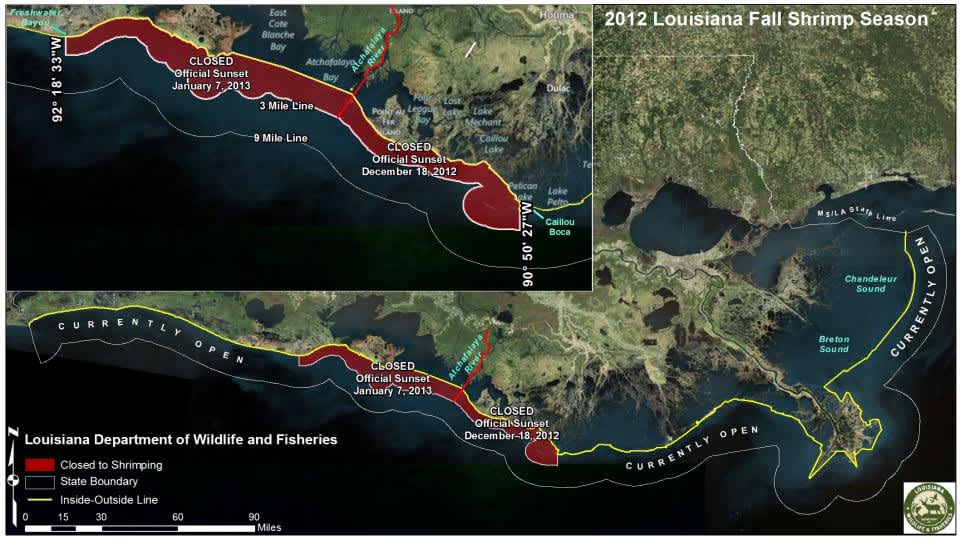Louisiana Wildlife and Fisheries Commission Takes Action to Close Portions of Louisiana Offshore Territorial Waters to Shrimping

At today’s meeting, the Louisiana Wildlife and Fisheries Commission announced two shrimping closures in portions of Louisiana offshore territorial (outside) waters. The action, which characteristically takes place at this time of year, is designed to protect small, white shrimp and provide the opportunity for these populations to grow to larger, more marketable sizes.
The closure includes the following areas and effective dates:
- The portion of state outside waters, south of the Inside/Outside Shrimp Line as described in LA R.S. 56:495 seaward a distance of three nautical miles, from the northwest shore of Caillou Boca at 90 degrees 50 minutes 27 seconds west longitude westward to the Atchafalaya River Ship Channel at Eugene Island as delineated by the Channel red buoy line will close to shrimping on Tuesday, December 18, 2012, at sunset. This area generally lies seaward of Terrebonne Parish.
- The portion of state outside waters, south of the Inside/Outside Shrimp Line as described in LA R.S. 56:495 seaward a distance of three nautical miles, from the Atchafalaya River Ship Channel at Eugene Island as delineated by the Channel red buoy line westward to the western shore of Freshwater Bayou Canal at 92 degrees 18 minutes 33 seconds west longitude will close to shrimping on Monday, January 7, 2013, at sunset. This area generally lies seaward of St. Mary, Iberia and Vermilion parishes.
All state outside waters east of the northwest shore of Caillou Boca as well as state outside waters west of Freshwater Bayou Canal and fishery jurisdiction waters claimed by the state beyond the three nautical mile closure zone will remain open to shrimping until further notice.
Current regulations state that the possession count on saltwater, white shrimp shall average no more than 100 (whole shrimp) count per pound, with the exception of October 15 through the third Monday in December, when there is no designated count.
Current sampling conducted by the Louisiana Department of Wildlife and Fisheries indicates that average white shrimp size in certain portions of these state outside waters is slightly larger than 100 count per pound; however, historical data indicate that significant numbers of smaller size white shrimp occupying coastal lakes and bays migrate into these waters as temperatures drop with the onset of winter. This action protects these small white shrimp and provides increased opportunity for growth to larger, more valuable sizes.
The Commission also authorized the LDWF Secretary to delay the closing date if marketable quantities of shrimp are available for harvest, close any part of state waters if biological and technical data indicate the need to do so, and to reopen any closed area when the closure is no longer necessary. The Secretary is also authorized to open and close special shrimp seasons in portions of inside waters where such a season would not detrimentally affect developing brown shrimp.
Shrimp are the state’s most valuable fishery, and Louisiana continues to lead the country in shrimp landings. In 2011, approximately 5,900 licensed Louisiana commercial shrimpers landed 92 million pounds of shrimp (all species combined/heads-on weight) that had a dockside value of $130 million.

